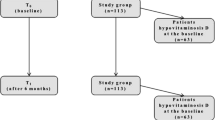Abstract.
The aims of this study were to investigate myopathy in relation to vitamin D status, and to study the muscular effects of vitamin D treatment on vitamin D-deficient individuals. Further, hypovitaminosis D myopathy was investigated in relation to alkaline phosphatase (ALP), the most commonly used marker for hypovitaminosis D osteopathy. Eight patients with osteomalacia had an isokinetic dynamometer test of all major muscle groups before and after 3 months of vitamin D treatment. The most pronounced improvements in muscle power were seen in the weight-bearing antigravity muscles of the lower limbs. A cross-sectional study was performed among 55 vitamin D-deficient veiled Arab women living in Denmark and 22 Danish controls. An isometric dynamometer model was used for determination of quadriceps muscle power. Both maximal voluntary contraction (MVC) and electrically stimulated values (single twitch, maximal production rate (MPR), and maximal relaxation rate (MRR)) were determined. The women underwent high-dose vitamin D treatment and were retested after 3 and 6 months. Prior to vitamin D treatment all parameters of muscle function in the group of vitamin D-deficient Arab women were significantly reduced compared with Danish controls. MVC: 259.4 ± 11.0 N (Newton) versus 392.6 ± 11.4 N (P < 10−6), single twitch: 47.0 ± 1.8 N versus 74.6 ± 2.2 N (P < 10−5), MPR 8.9 ± 0.3 N/10 ms versus 14.3 ± 0.4 N/10 ms (P < 10−6), MRR 4.5 ± 0.2 N/10 ms versus 6.2 ± 0.2 N/10 ms (P < 10−6). Muscle function was affected to a similar degree in women with and without bone involvement (as indicated by elevated ALP). After 3 months of vitamin D treatment all muscle-related parameters improved significantly. After 6 months only MVC was reduced compared with Danish controls (320.7 ± 14.3 N (P < 0.02)), whereas all other measurements were normalized. Hypovitaminosis D myopathy is a prominent symptom of vitamin D deficiency, and severely impaired muscle function may be present even before biochemical signs of bone disease develop. Full normalization of hypovitaminosis D myopathy demands high-dose vitamin D treatment for 6 months or more. Our findings indicate that serum levels of ALP cannot be used in the screening for hypovitaminosis D myopathy. Assessment of s-25OHD is the only reliable test.
Similar content being viewed by others
Author information
Authors and Affiliations
Additional information
Received: 10 September 1999 / Accepted: 11 January 2000
Rights and permissions
About this article
Cite this article
Glerup, H., Mikkelsen, K., Poulsen, L. et al. Hypovitaminosis D Myopathy Without Biochemical Signs of Osteomalacic Bone Involvement. Calcif Tissue Int 66, 419–424 (2000). https://doi.org/10.1007/s002230010085
Published:
Issue Date:
DOI: https://doi.org/10.1007/s002230010085




